Abstract
Early suggestions that a humoral factor might be implicated in the disorder of neuromuscular transmission in myasthenia gravis have been confirmed by the detection of anti-AChR antibody in 85-90% of the patients with generalised disease and in 75% of cases with restricted ocular myasthenia. Plasma exchange reveals that serum anti-AChR usually has an inverse relationship to muscle strength and present evidence indicates that patients responding to thymectomy and immunosuppressive durg treatment usually show a consistent decline in serum anti-AChR titres. The antibody is heterogeneous and can lead to a loss of muscle AChR by several mechanisms. Anti-AChR is produced in the thymus in relatively small amounts. Anti-AChR antibody synthesis by thymic lymphocytes and pokeweed stimulated peripheral lymphocytes in culture provides a means of studying the effect of different lymphocyte populations in vitro. Analysis of clinical, immunological and HLA antigen characteristics in MG suggest that more than one mechanism may underlie the breakdown in tolerance to AChR, leading to the production of anti-AChR antibodies.
Full text
PDF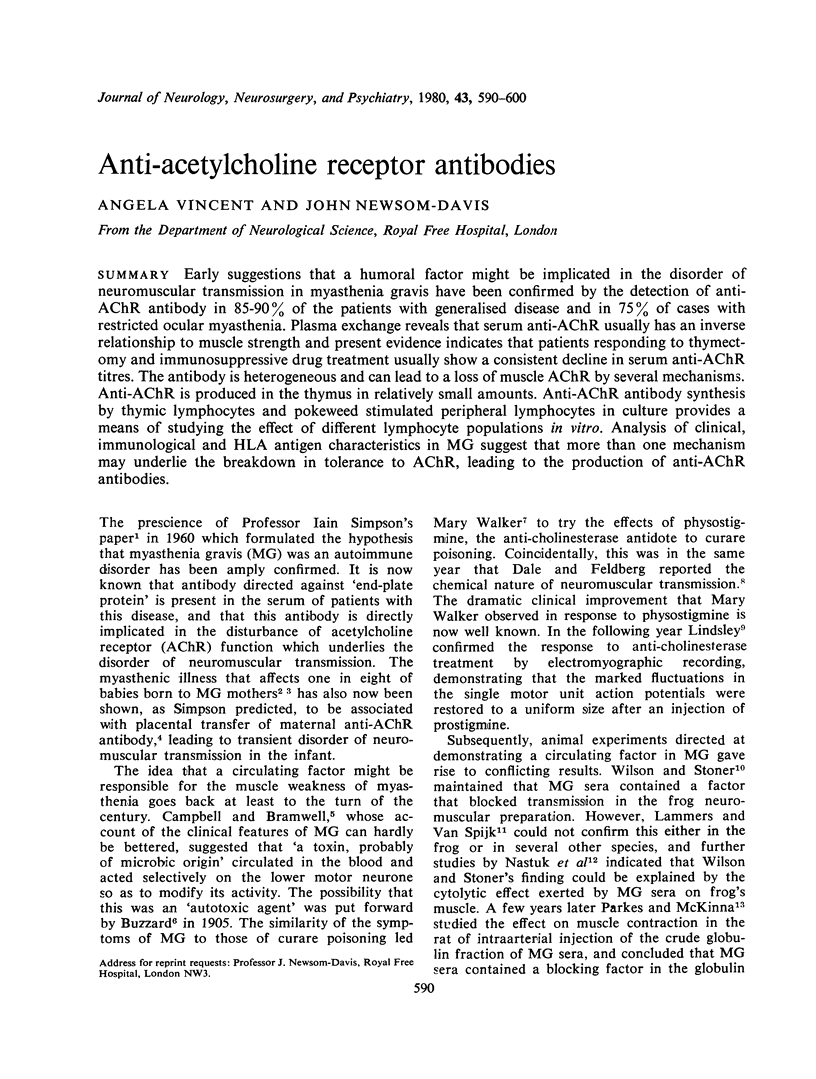

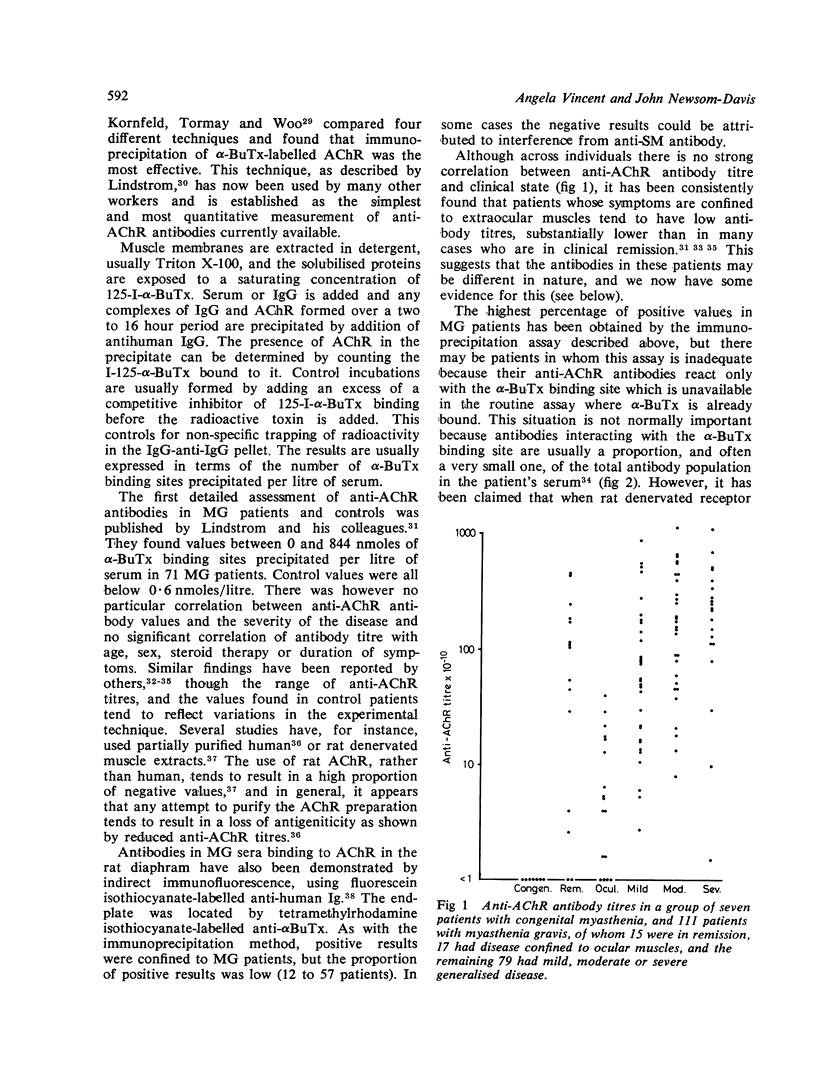

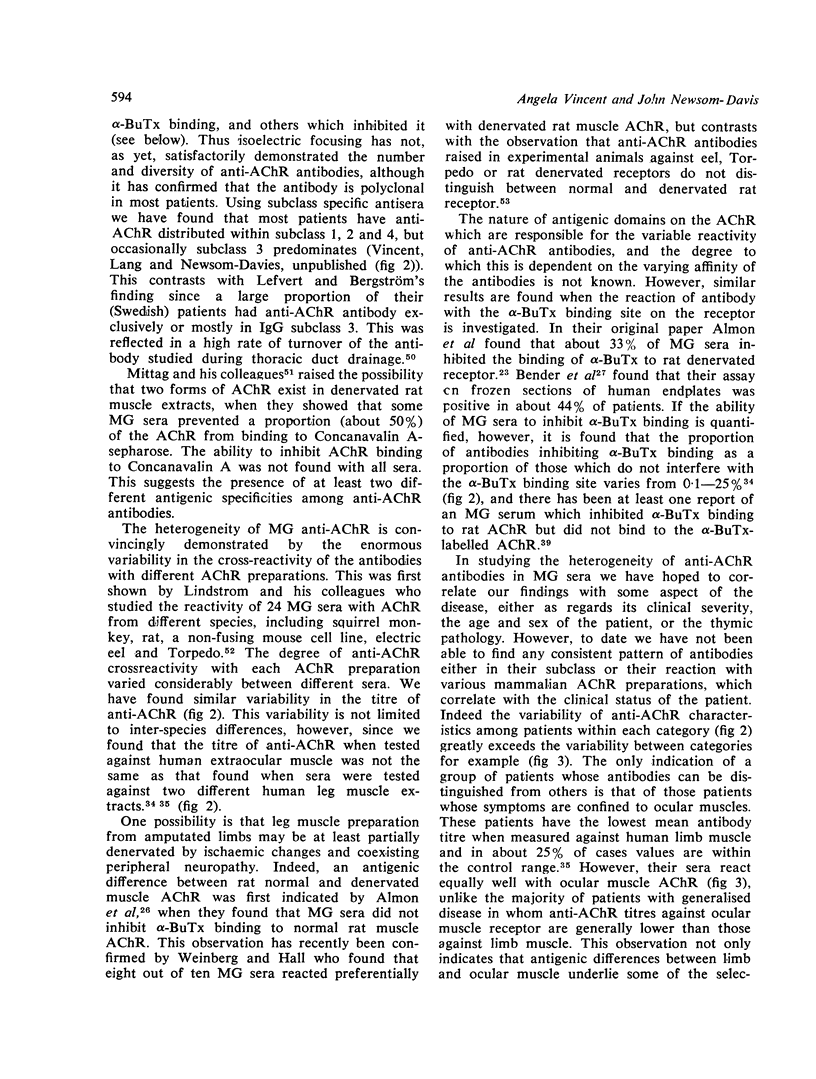
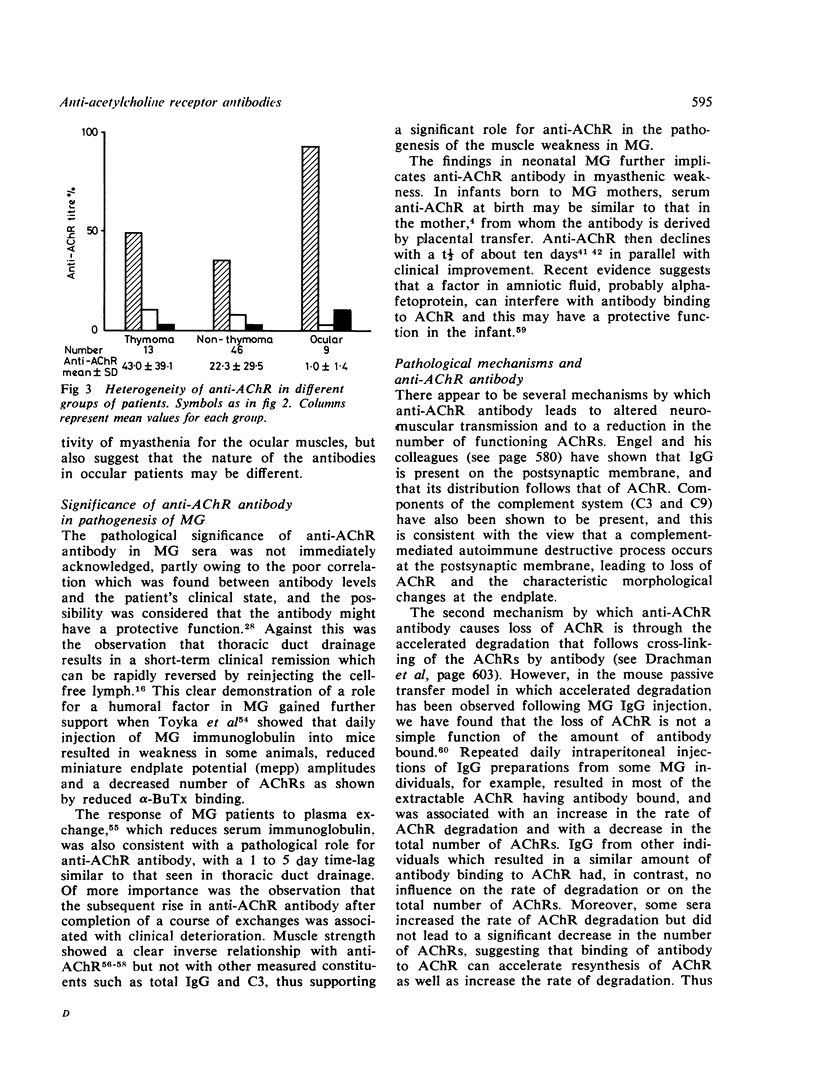


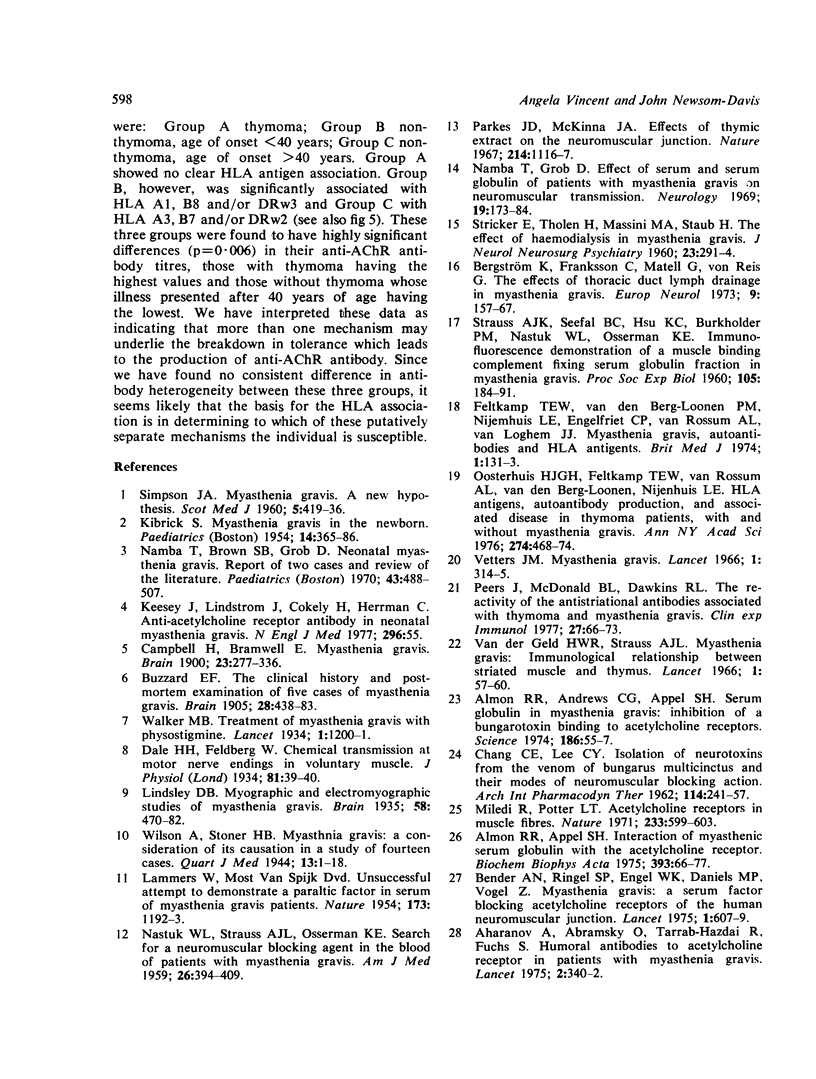


Selected References
These references are in PubMed. This may not be the complete list of references from this article.
- Abramsky O., Brenner T., Lisak R. P., Zeidman A., Beyth Y. Significance in neonatal myasthenia gravis of inhibitory effect of amniotic fluid on binding of antibodies to acetylcholine receptor. Lancet. 1979 Dec 22;2(8156-8157):1333–1335. doi: 10.1016/s0140-6736(79)92815-0. [DOI] [PubMed] [Google Scholar]
- Aharonov A., Abramsky O., Tarrab-Hazdai R., Fuchs S. Humoral antibodies to acetylcholine receptor in patients with myasthenia gravis. Lancet. 1975 Aug 23;2(7930):340–342. doi: 10.1016/s0140-6736(75)92779-8. [DOI] [PubMed] [Google Scholar]
- Almon R. R., Andrew C. G., Appel S. H. Serum globulin in myasthenia gravis: inhibition of alpha-bungarotoxin binding to acetylcholine receptors. Science. 1974 Oct 4;186(4158):55–57. doi: 10.1126/science.186.4158.55. [DOI] [PubMed] [Google Scholar]
- Almon R. R., Appel S. H. Interaction of myasthenic serum globulin with the acetylcholine receptor. Biochim Biophys Acta. 1975 May 30;393(1):66–77. doi: 10.1016/0005-2795(75)90217-2. [DOI] [PubMed] [Google Scholar]
- Argov Z., Nicholson L., Fawcett P. R., Mastaglia F. L., Hall M. Neuromuscular transmission and acetylcholine receptor antibodies in rheumatoid arthritis patients on D-penicillamine. Lancet. 1980 Jan 26;1(8161):203–203. doi: 10.1016/s0140-6736(80)90686-8. [DOI] [PubMed] [Google Scholar]
- Bender A. N., Ringel S. P., Engel W. K., Daniels M. P., Vogel Z. Myasthenia gravis: a serum factor blocking acetylcholine receptors of the human neuromuscular junction. Lancet. 1975 Mar 15;1(7907):607–609. doi: 10.1016/s0140-6736(75)91886-3. [DOI] [PubMed] [Google Scholar]
- Bergström K., Franksson C., Matell G., von Reis G. The effect of thoracic duct lymph drainage in myasthenia gravis. Eur Neurol. 1973;9(3):157–167. doi: 10.1159/000114221. [DOI] [PubMed] [Google Scholar]
- Bradley R. J., Dwyer D., Morley B. J., Robinson G., Kemp G. E., Oh S. J. Humoral immunity in myasthenia gravis: relationship to disease severity and steroid treatment. Lancet. 1978 Jul 8;2(8080):96–96. doi: 10.1016/s0140-6736(78)91402-2. [DOI] [PubMed] [Google Scholar]
- Brenner T., Abramsky O., Lisak R. P., Zweiman B., Tarrab-Hazdai R., Fuchs S. Radioimmunoassay of antibodies to acetylcholine receptor in serum of myasthenia gravis patients. Isr J Med Sci. 1978 Sep;14(9):986–989. [PubMed] [Google Scholar]
- Bucknall R. C., Dixon A St J., Glick E. N., Woodland J., Zutshi D. W. Myasthenia gravis associated with penicillamine treatment for rheumatoid arthritis. Br Med J. 1975 Mar 15;1(5958):600–602. doi: 10.1136/bmj.1.5958.600. [DOI] [PMC free article] [PubMed] [Google Scholar]
- Datta S. K., Schwartz R. S. Editorial: Infectious (?) myasthenia. N Engl J Med. 1974 Dec 12;291(24):1304–1305. doi: 10.1056/NEJM197412122912411. [DOI] [PubMed] [Google Scholar]
- Dau P. C., Lindstrom J. M., Cassel C. K., Denys E. H., Shev E. E., Spitler L. E. Plasmapheresis and immunosuppressive drug therapy in myasthenia gravis. N Engl J Med. 1977 Nov 24;297(21):1134–1140. doi: 10.1056/NEJM197711242972102. [DOI] [PubMed] [Google Scholar]
- Dwyer D. S., Bradley R. J., Oh S. J., Kemp G. E. A modified assay for antibody against the nicotinic acetylcholine receptor in myasthenia gravis. Clin Exp Immunol. 1979 Sep;37(3):448–451. [PMC free article] [PubMed] [Google Scholar]
- Engel E. K., Trotter J. L., McFarlin D. E., McIntosh C. L. Thymic epithelial cell contains acetylcholine receptor. Lancet. 1977 Jun 18;1(8025):1310–1311. doi: 10.1016/s0140-6736(77)91343-5. [DOI] [PubMed] [Google Scholar]
- Feltkamp T. E., van den Berg-Loonen P. M., Nijenhuis L. E., Engelfriet C. P., van Rossum A. L., van Loghem J. J., Oosterhuis H. J. Myasthenia gravis, autoantibodies, and HL-A antigens. Br Med J. 1974 Jan 26;1(5899):131–133. doi: 10.1136/bmj.1.5899.131. [DOI] [PMC free article] [PubMed] [Google Scholar]
- HENSON R. A., STERN G. M., THOMPSON V. C. THYMECTOMY FOR MYASTHENIA GRAVIS. Brain. 1965 Mar;88:11–28. doi: 10.1093/brain/88.1.11. [DOI] [PubMed] [Google Scholar]
- Henry K. An unusual thymic tumour with a striated muscle (myoid) component (with a brief review of the literature on myoid cells). Br J Dis Chest. 1972 Oct;66(4):291–299. doi: 10.1016/0007-0971(72)90050-2. [DOI] [PubMed] [Google Scholar]
- KIBRICK S. Myasthenia gravis in the newborn. Pediatrics. 1954 Oct;14(4):365–386. [PubMed] [Google Scholar]
- Kao I., Drachman D. B. Thymic muscle cells bear acetylcholine receptors: possible relation to myasthenia gravis. Science. 1977 Jan 7;195(4273):74–75. doi: 10.1126/science.831257. [DOI] [PubMed] [Google Scholar]
- Keesey J., Lindstrom J., Cokely H. Anti-acetylcholine receptor antibody in neonatal myasthenia gravis. N Engl J Med. 1977 Jan 6;296(1):55–55. doi: 10.1056/NEJM197701062960125. [DOI] [PubMed] [Google Scholar]
- LAMMERS W., MOST VAN SPIJK D. Unsuccessful attempt to demonstrate a paralytic factor in serum of myasthenia gravis patients. Nature. 1954 Jun 19;173(4416):1192–1193. doi: 10.1038/1731192b0. [DOI] [PubMed] [Google Scholar]
- Lefvert A. K., Bergström K. Acetylcholine receptor antibody in myasthenia gravis: purification and characterization. Scand J Immunol. 1978;8(6):525–533. doi: 10.1111/j.1365-3083.1978.tb00552.x. [DOI] [PubMed] [Google Scholar]
- Lefvert A. K., Bergström K., Matell G., Osterman P. O., Pirskanen R. Determination of acetylcholine receptor antibody in myasthenia gravis: clinical usefulness and pathogenetic implications. J Neurol Neurosurg Psychiatry. 1978 May;41(5):394–403. doi: 10.1136/jnnp.41.5.394. [DOI] [PMC free article] [PubMed] [Google Scholar]
- Lefvert A. K. Immunoglobulins in myasthenia gravis. Kinetic properties of the acetylcholine-receptor antibody studied during lymph drainage. Clin Exp Immunol. 1978 Oct;34(1):111–117. [PMC free article] [PubMed] [Google Scholar]
- Lindstrom J. M., Seybold M. E., Lennon V. A., Whittingham S., Duane D. D. Antibody to acetylcholine receptor in myasthenia gravis. Prevalence, clinical correlates, and diagnostic value. Neurology. 1976 Nov;26(11):1054–1059. doi: 10.1212/wnl.26.11.1054. [DOI] [PubMed] [Google Scholar]
- Lindstrom J. An assay for antibodies to human acetylcholine receptor in serum from patients with myasthenia gravis. Clin Immunol Immunopathol. 1977 Jan;7(1):36–43. doi: 10.1016/0090-1229(77)90027-7. [DOI] [PubMed] [Google Scholar]
- Lindstrom J., Campbell M., Nave B. Specificities of antibodies to acetylcholine receptors. Muscle Nerve. 1978 Mar-Apr;1(2):140–145. doi: 10.1002/mus.880010206. [DOI] [PubMed] [Google Scholar]
- Masters C. L., Dawkins R. L., Zilko P. J., Simpson J. A., Leedman R. J. Penicillamine-associated myasthenia gravis, antiacetylcholine receptor and antistriational antibodies. Am J Med. 1977 Nov;63(5):689–694. doi: 10.1016/0002-9343(77)90153-x. [DOI] [PubMed] [Google Scholar]
- Miledi R., Potter L. T. Acetylcholine receptors in muscle fibres. Nature. 1971 Oct 29;233(5322):599–603. doi: 10.1038/233599a0. [DOI] [PubMed] [Google Scholar]
- Mittag T. W., Tormay A., Massa T. Heterogeneity of acetylcholine receptors in denervated muscle: interactions of receptors with immunoglobulin from patients with myasthenia gravis. Mol Pharmacol. 1978 Jan;14(1):60–68. [PubMed] [Google Scholar]
- Mittag T., Kornfeld P., Tormay A., Woo C. Detection of anti-acetylcholine receptor factors in serum and thymus from patients with myasthenia gravis. N Engl J Med. 1976 Mar 25;294(13):691–694. doi: 10.1056/NEJM197603252941303. [DOI] [PubMed] [Google Scholar]
- Monnier V. M., Fulpius B. W. A radioimmunoassay for the quantitative evaluation of anti-human acetylcholine receptor antibodies in myasthenia gravis. Clin Exp Immunol. 1977 Jul;29(1):16–22. [PMC free article] [PubMed] [Google Scholar]
- NASTUK W. L., PLESCIA O. J., OSSERMAN K. E. Changes in serum complement activity in patients with myasthenia gravis. Proc Soc Exp Biol Med. 1960 Oct;105:177–184. doi: 10.3181/00379727-105-26050. [DOI] [PubMed] [Google Scholar]
- NASTUK W. L., STRAUSS A. J., OSSERMAN K. E. Search for a neuromuscular blocking agent in the blood of patients with myasthenia gravis. Am J Med. 1959 Mar;26(3):394–409. doi: 10.1016/0002-9343(59)90248-7. [DOI] [PubMed] [Google Scholar]
- Namba T., Brown S. B., Grob D. Neonatal myasthenia gravis: report of two cases and review of the literature. Pediatrics. 1970 Mar;45(3):488–504. [PubMed] [Google Scholar]
- Namba T., Grob D. Effect of serum and serum globulin of patients with myasthenia gravis on neuromuscular transmission. Neurology. 1969 Feb;19(2):173–184. doi: 10.1212/wnl.19.2.173. [DOI] [PubMed] [Google Scholar]
- Newsom-Davis J., Pinching A. J., Vincent A., Wilson S. G. Function of circulating antibody to acetylcholine receptor in myasthenia gravis: investigation by plasma exchange. Neurology. 1978 Mar;28(3):266–272. doi: 10.1212/wnl.28.3.266. [DOI] [PubMed] [Google Scholar]
- Newsom-Davis J., Wilson S. G., Vincent A., Ward C. D. Long-term effects of repeated plasma exchange in myasthenia gravis. Lancet. 1979 Mar 3;1(8114):464–468. doi: 10.1016/s0140-6736(79)90823-7. [DOI] [PubMed] [Google Scholar]
- Oosterhuis H. J., Feltkamp T. E., van Rossum A. L., van den Berg-Loonen P. M., Nijenhuis L. E. HL-A antigens, autoantibody production, and associated diseases in thymoma patients, with and without myasthenia gravis. Ann N Y Acad Sci. 1976;274:468–474. doi: 10.1111/j.1749-6632.1976.tb47708.x. [DOI] [PubMed] [Google Scholar]
- Papatestas A. E., Alpert L. I., Osserman K. E., Osserman R. S., Kark A. E. Studies in myasthenia gravis: effects of thymectomy. Results on 185 patients with nonthymomatous and thymomatous myasthenia gravis, 1941-1969. Am J Med. 1971 Apr;50(4):465–474. doi: 10.1016/0002-9343(71)90336-6. [DOI] [PubMed] [Google Scholar]
- Parkes J. D., McKinna J. A. Effects of thymic extract on the neuromuscular junction. Nature. 1967 Jun 10;214(5093):1116–1117. doi: 10.1038/2141116a0. [DOI] [PubMed] [Google Scholar]
- Peers J., McDonald B. L., Dawkins R. L. The reactivity of the antistriational antibodies associated with thymoma and myasthenia gravis. Clin Exp Immunol. 1977 Jan;27(1):66–73. [PMC free article] [PubMed] [Google Scholar]
- Pinching A. J., Peters D. K. Remission of myasthenia gravis following plasma-exchange. Lancet. 1976 Dec 25;2(8000):1373–1376. doi: 10.1016/s0140-6736(76)91917-6. [DOI] [PubMed] [Google Scholar]
- Rowland L. P., Osserman E. F., Scharfman W. B., Balsam R. F., Ball S. Myasthenia gravis with a myeloma-type, gamma-G (IgG) immunoglobulin abnormality. Am J Med. 1969 Apr;46(4):599–605. doi: 10.1016/0002-9343(69)90078-3. [DOI] [PubMed] [Google Scholar]
- Russell A. S., Lindstrom J. M. Penicillamine-induced myasthenia gravis associated with antibodies to acetylcholine receptor. Neurology. 1978 Aug;28(8):847–849. doi: 10.1212/wnl.28.8.847. [DOI] [PubMed] [Google Scholar]
- SIMPSON J. A. An evaluation of thymectomy in myasthenia gravis. Brain. 1958 Mar;81(1):112–144. doi: 10.1093/brain/81.1.112. [DOI] [PubMed] [Google Scholar]
- Scratcherd T. Two of the newer 'gastrointestinal hormones'. Clin Sci (Lond) 1979 Jan;56(1):1–7. doi: 10.1042/cs0560001. [DOI] [PubMed] [Google Scholar]
- Shibuya N., Mori K., Nakazawa Y. Serum factor blocks neuromuscular transmission in myasthenia gravis: electrophysiologic study with intracellular microelectrodes. Neurology. 1978 Aug;28(8):804–811. doi: 10.1212/wnl.28.8.804. [DOI] [PubMed] [Google Scholar]
- Shore A., Limatibul S., Dosch H. M., Gelfand E. W. Identification of two serum components regulating the expression of T-lymphocyte function in childhood myasthenia gravis. N Engl J Med. 1979 Sep 20;301(12):625–629. doi: 10.1056/NEJM197909203011202. [DOI] [PubMed] [Google Scholar]
- Siegal F. P., Siegal M. Enhancement by irradiated T cells of human plasma cell production: dissection of helper and suppressor functions in vitro. J Immunol. 1977 Feb;118(2):642–647. [PubMed] [Google Scholar]
- Somer H., Pirskanen R., Lefvert A. K., Wasastjerna C., Konttinen A. Myasthenia gravis and monoclonal IgG gammopathy. Neurology. 1979 Jun;29(6):842–847. doi: 10.1212/wnl.29.6.842. [DOI] [PubMed] [Google Scholar]
- Sondag-Tschroots I. R., Schulz-Raateland R. C., van Walbeek H. K., Feltkamp T. E. Antibodies to motor endplates demonstrated with the immunofluorescence technique. Clin Exp Immunol. 1979 Aug;37(2):323–327. [PMC free article] [PubMed] [Google Scholar]
- Toyka K. V., Drachman D. B., Griffin D. E., Pestronk A., Winkelstein J. A., Fishbeck K. H., Kao I. Myasthenia gravis. Study of humoral immune mechanisms by passive transfer to mice. N Engl J Med. 1977 Jan 20;296(3):125–131. doi: 10.1056/NEJM197701202960301. [DOI] [PubMed] [Google Scholar]
- Vetters J. M., Simpson J. A. Comparison of thymic histology with response to thymectomy in myasthenia gravis. J Neurol Neurosurg Psychiatry. 1974 Oct;37(10):1139–1145. doi: 10.1136/jnnp.37.10.1139. [DOI] [PMC free article] [PubMed] [Google Scholar]
- Vincent A., Newsom-Davis J. Absence of anti-acetylcholine receptor antibodies in congenital myasthenia gravis. Lancet. 1979 Feb 24;1(8113):441–442. doi: 10.1016/s0140-6736(79)90918-8. [DOI] [PubMed] [Google Scholar]
- Vincent A., Newsom-Davis J. alpha-Bungarotoxin and anti-acetylcholine receptor antibody binding to the human acetylcholine receptor. Adv Cytopharmacol. 1979;3:269–278. [PubMed] [Google Scholar]
- Vincent A., Scadding G. K., Thomas H. C., Newsom-Davis J. In-vitro synthesis of anti-acetylcholine-receptor antibody by thymic lymphocytes in myasthenia gravis. Lancet. 1978 Feb 11;1(8059):305–307. doi: 10.1016/s0140-6736(78)90073-9. [DOI] [PubMed] [Google Scholar]
- Weinberg C. B., Hall Z. W. Antibodies from patients with myasthenia gravis recognize determinants unique to extrajunctional acetylcholine receptors. Proc Natl Acad Sci U S A. 1979 Jan;76(1):504–508. doi: 10.1073/pnas.76.1.504. [DOI] [PMC free article] [PubMed] [Google Scholar]
- van der Geld H. W., Strauss A. J. Myasthenia gravis. Immunological relationship between striated muscle and thymus. Lancet. 1966 Jan 8;1(7428):57–60. doi: 10.1016/s0140-6736(66)92356-7. [DOI] [PubMed] [Google Scholar]


